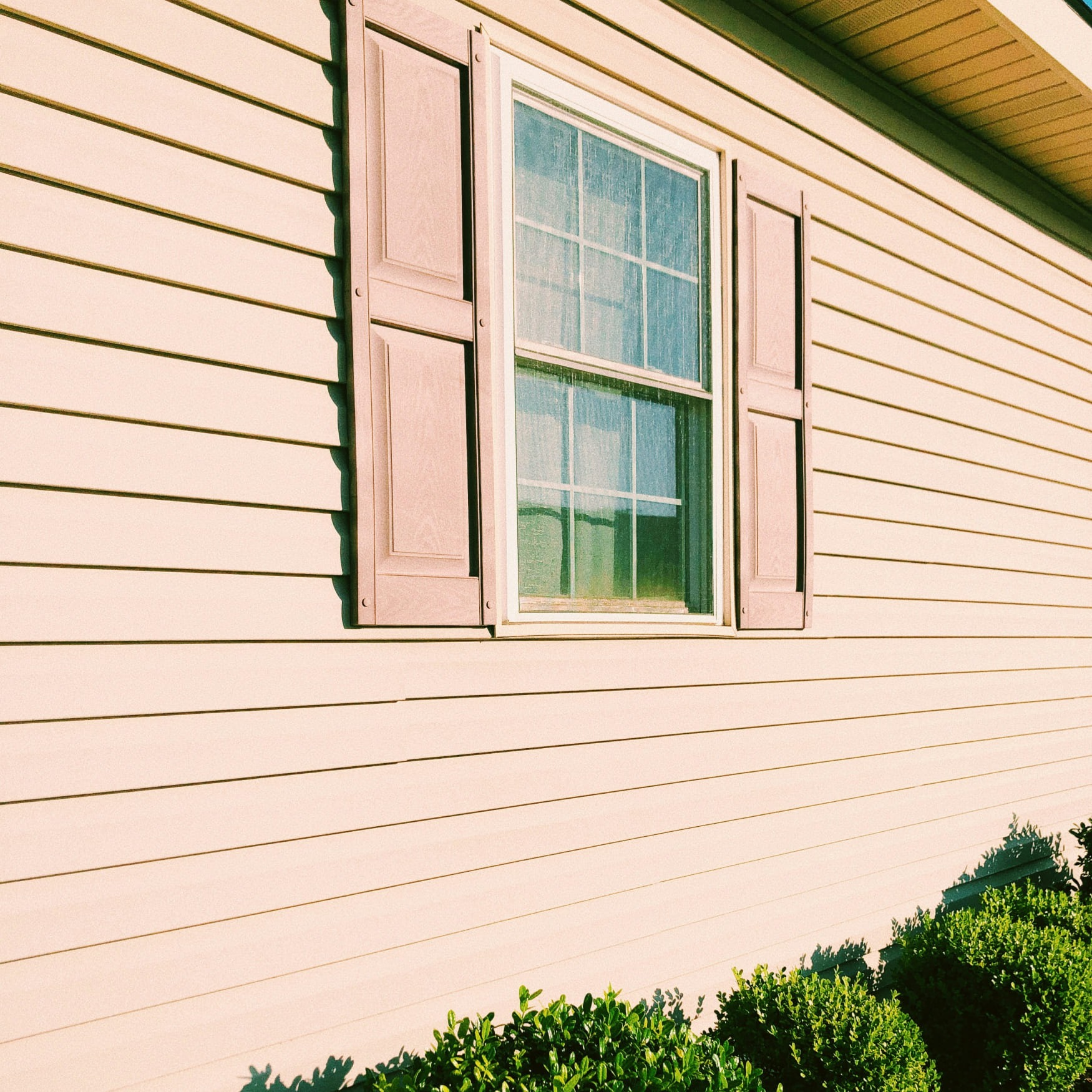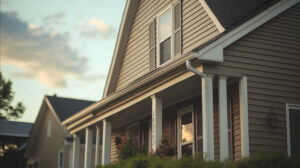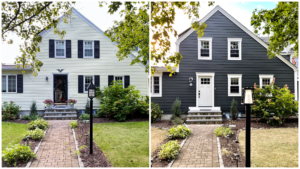

Project Manager at Plum ProExteriors
Best Homemade Siding Cleaner Solutions

It is obvious that your property’s appeal suffers when its once-vibrant siding becomes dull and unclean. We know that maintaining the exterior of your house can be quite a challenging task, especially when it comes to keeping your siding clean and free from stains. While commercial cleaners are readily available, they often contain harsh chemicals that may not be ideal for your health or the environment. Thankfully, there are alternative solutions that are both eco-friendly and effective.
In this article, prepared by experts at Plum ProExteriors, we’ll explore various homemade siding cleaners’ recipes using common household ingredients. White vinegar, baking soda, dish soap, and oxygen bleach offer a cost-effective and sustainable way to keep your siding looking its best. To clean your siding, you should pick the proper ingredients and select the recipe. Then, test the ingredients on a small area and scrub the siding.
Let’s discover the power of homemade siding cleaners together!
Reasons for siding dirtiness
Before exploring cleaning methods, it’s vital to comprehend why siding accumulates grime in the first place. While it may seem perplexing that exterior walls become dingy so swiftly, several factors contribute to this phenomenon:
- Shaded areas: The orientation of your home plays a pivotal role, with one side often remaining perpetually shaded. Such areas, devoid of sunlight exposure, provide an ideal environment for mildew, moss, and mold to flourish, particularly in humid climates.
- Low foundations: A low foundation heightens the likelihood of dirt accumulation on your home’s exterior. When rain splashes against the ground, it can create mud splatters that gradually form a gritty film along the bottom few feet of your siding. While taller foundations made of brick, stone, or concrete are not immune to splash-back, their textured surfaces often camouflage the mud.
- White siding: The allure of pristine white siding comes with a caveat: it’s notoriously difficult to keep clean. Just as a white button-down shirt is prone to stains, white siding accentuates every speck of dirt or buildup. Unlike darker hues that can mask imperfections, white siding leaves no room for concealment, necessitating more frequent cleaning to maintain its pristine appearance.

Understanding the various factors contributing to siding dirtiness empowers homeowners to implement effective cleaning strategies tailored to their specific needs and circumstances.
Listed below are some prevalent challenges that homeowners encounter necessitating cleaning:
- Exposure to environmental elements: Siding is constantly exposed to UV rays, high winds, rainstorms, winter weather, bird droppings, and pollution. These elements collectively contribute to the degradation of its appearance over time.
- Mold and mildew formation: Moisture, whether from high humidity, rainfall, or melting snow, creates conducive conditions for mold and mildew growth. Areas of the home receiving limited sunlight are particularly susceptible to these fungal infestations.
- Staining: Various sources contribute to unsightly stains on the siding. Reddish-brown stains may result from rusty nails, while black and green stains are typically caused by mold, fungus, or algae. Yellow stains indicate insulation deterioration or sheathing behind the siding, often exacerbated by gutter issues.
- Chalk accumulation: Chalking occurs when UV light interacts with paint chemicals, resulting in the formation of powdery residue on the siding surface. This residue, comprised of oxidized paint components, contributes to the siding’s chalky appearance.
- Debris and dirt buildup: Debris and dirt propelled by winds accumulate on siding surfaces, settling into crevices and gaps. After rainstorms, this accumulated debris can lead to streaking stains, detracting from the visual appeal of your home’s exterior.
In the following sections, we will explore homemade solutions and techniques for effectively cleaning siding and restoring its pristine condition.
Want a modern home look? Our experts at Plum ProExterious will help. Contact us.
Benefits of homemade siding cleaning solutions
Using homemade siding cleaners offers many benefits beyond just cleanliness. These are more cost-effective, eco-friendly, and safer, and this is not the whole list of pros. Let’s consider them all.

Cost-effective
Firstly, these DIY (Do it Yourself) cleaners are often crafted from household staples, saving you money while reducing your environmental footprint. By utilizing ingredients that you likely already have in your pantry or under the sink, such as vinegar, baking soda, and lemon juice, you eliminate the need to purchase expensive commercial cleaning products regularly. This cost-effective approach to house maintenance enables you to target your resources more efficiently. Thus, you can free up your budget for other household necessities or personal indulgences.
Eco-friendly
Unlike their commercial counterparts, which include harsh chemicals, cleaning siding with vinegar and baking soda and others include natural components. This ensures a safer cleaning experience for both you and the environment. Your contribution will be great because you will promote a healthier planet for future generations.
Safer for siding itself
Moreover, homemade solutions can be tailored to suit different siding materials and levels of grime, providing a versatile cleaning option for every homeowner. By using natural ingredients such as oxygen bleach and lemon juice, tough stains, and mildew are effectively eradicated without harming the siding surface.
Versatile and customizable
Choosing homemade cleaners gives you greater control over the cleaning process, from ingredient selection to application method. You can pick the appropriate solution that suits your type of siding better by yourself.
The benefits of homemade siding cleaning solutions extend far beyond mere cleanliness, offering a great alternative to commercial products. By embracing these DIY solutions, you not only achieve a sparkling exterior but also contribute to a greener, healthier home environment.
Ingredients commonly used in siding cleaner recipes
When it comes to crafting effective homemade siding cleaning solutions, certain ingredients stand out for their cleaning prowess and versatility. These household staples offer powerful cleaning properties while remaining gentle on your siding surface. Below, we will consider the key ingredients commonly used in DIY siding cleaner recipes:
- White vinegar: A staple in many homemade cleaning solutions, white vinegar is prized for its acidic nature, which helps dissolve dirt, grime, and mineral deposits. Cleaning vinyl siding with vinegar is particularly effective at removing mildew stains. A 30% white vinegar with 70% water added creates an all-purpose siding cleaner.
- Baking soda: Known for its abrasive yet non-toxic properties, baking soda serves as a gentle scrubbing agent that helps lift stubborn stains from siding surfaces. You can use it to tackle the siding without damaging the underlying material.
- Lemon juice: With its natural acidity, lemon juice is a popular addition to DIY siding cleaner recipes. It not only helps break down dirt and grime but also imparts a fresh, citrusy fragrance to your cleaning solution.
- Dish soap: Mild dish soap is an essential ingredient for creating sudsy, foaming cleaners that effectively lift away dirt and grease from siding surfaces. Look for eco-friendly, biodegradable options to minimize environmental influence.
- Hydrogen peroxide: This mild disinfectant and bleaching agent is commonly used to brighten and whiten dingy or discolored siding. It’s particularly effective at removing mold and mildew stains without harsh chemicals.
- Oxygen bleach: Unlike chlorine bleach, oxygen bleach is environmentally friendly and non-toxic, making it a safer alternative for cleaning siding. It’s highly effective at removing tough stains, including mold, mildew, and algae, without damaging surrounding vegetation.
Apply the cleaning power of these common household ingredients and create vinyl siding cleaner homemade solutions that effectively remove dirt, stains, and grime. We will talk about how to make such cleansers in the next section.
Instructions for using homemade siding cleaning solutions
Mastering the art of homemade siding cleaning solutions is a gratifying journey that allows you to tailor your cleaning approach while minimizing environmental impact. Armed with a handful of household essentials, you can make potent cleaners tailored to your specific needs. Here’s your personalized roadmap to crafting homemade siding cleaning solutions:

Step 1: Gather your ingredients
Begin by gathering the essential components required for your chosen homemade siding cleaning concoction. From white vinegar and baking soda to lemon juice and hydrogen peroxide, ensure you have all the necessary ingredients in the right proportions before embarking on your cleaning adventure.
Step 2: Choose the right recipe
Navigate through a plethora of homemade siding cleaners’ recipes to cherry-pick the one that resonates with your cleaning aspirations and siding material. Whether it’s banishing mildew with DIY vinyl siding cleaner or lifting grime from wood panels, there’s a recipe tailored to your needs. Keep an eye out for ingredient availability, eco-friendliness, and effectiveness as you make your selection.
Examples of recipes
Here, you can see some popular recipes that homeowners use to clean their home siding. Use our selection if you are looking at how to clean vinyl siding with vinegar and more.
Vinegar and water solution
Ingredients:
- 1 part white vinegar,
- 1 part water.
Instructions:
- Keep an equal bleach to water ratio for cleaning vinyl siding.
- Mix parts of water and white vinegar in a spray bottle.
- Shake well to ensure thorough mixing.
- Spray the solution onto the siding surface and let it sit for several minutes.
- Scrub gently with a soft-bristled sponge or brush.
- Rinse the siding with water to remove any residue.
Baking soda paste
Ingredients:
- 1/2 cup baking soda,
- Add water (in amount as needed to form a paste).
Instructions:
- Combine the baking soda with enough water in a small bowl to form a thick paste.
- Apply the paste to the stained areas of the siding using a sponge or soft-bristled brush.
- Allow the paste to sit for 10-15 minutes to penetrate the stains.
- Scrub the area gently with a sponge or brush.
- Rinse the siding thoroughly with water to remove the paste and any loosened dirt or grime.
Lemon juice and dish soap solution
Ingredients:
- 1/4 cup lemon juice,
- 1 teaspoon dish soap,
- 1 gallon of water.
Instructions:
- In a large bucket, mix together the dish soap, lemon juice, and water.
- Stir well to ensure the ingredients are thoroughly mixed.
- Dip a soft-bristled brush or a sponge into the cleaning solution and apply it to the siding surface.
- Scrub gently to lift dirt and stains.
- Rinse thoroughly with water to remove the cleaning solution.
Hydrogen peroxide and water solution
Ingredients:
- 1 part hydrogen peroxide,
- 2 parts water.
Instructions:
- Mix water and hydrogen peroxide in a spray bottle.
- Shake well to combine.
- Spray the solution onto the siding surface, focusing on areas with mildew or mold stains.
- Let the solution sit for 10-15 minutes.
- Scrub the stained areas gently with a soft-bristled brush.
- Rinse thoroughly with water to delete any particles.
Step 3: Mix ingredients
Follow the recipe instructions meticulously, blending the ingredients with precision and finesse. If you are looking to learn how to clean vinyl siding with vinegar or other potent substances, stir your concoction thoroughly, ensuring every component melds seamlessly.
Step 4: Test on a small area
Exercise caution by conducting a preliminary test on a discreet patch of siding before applying your homemade cleaner solution wholesale. This precautionary measure allows you to gauge compatibility with your siding material and preempt any adverse reactions. Patiently await the test area’s verdict before proceeding.
Step 5: Meticulously apply the solution
With the green light from your patch test, proceed to apply your DIY house siding cleaner solution to the entirety of the siding surface. Equip yourself with a spray bottle or a trusty bucket and sponge, working methodically to ensure even distribution. Divide and conquer, tackling manageable sections to prevent premature solution evaporation.
Step 6: Gently scrub and rinse
For stubborn blemishes or heavily soiled spots, employ a gentle touch as you scrub the siding with a soft-bristled brush or sponge. Opt for a lengthy-handled brush because it enables access to elevated areas sans the need for a ladder, though any brush will suffice. Alternatively, employing a sponge or cloth is viable. You should avoid rigid bristles, steel wool, or similar abrasive substances, as they can mar the surface, especially vinyl ones.

Once the grime surrenders to your efforts, rinse the siding meticulously with clear water to expunge any lingering residues, unveiling a rejuvenated facade.
Step 7: Enjoy your clean siding
With the cleaning crusade concluded, bask in the glory of your handiwork. Behold your gleaming siding, liberated from the clutches of dirt and stains. Now, you know you’ve achieved a pristine exterior using bespoke, budget-friendly home made vinyl siding cleaner solutions.
Washing as an additional way of siding cleaning
An alternative for siding cleaning is employing pressure washing. This method utilizes specialized equipment to propel water at high pressure onto the siding. The forceful pressure mimics the action of a brush, driving soapy water into crevices and dislodging embedded dirt. Subsequently, the water effortlessly rinses away the dislodged debris.
In contrast to manual scrubbing with a brush or sponge, power-washing siding offers swifter results with minimal exertion on your part. Furthermore, it ensures a comprehensive, thorough cleaning by accessing areas that may be inaccessible to traditional cleaning tools.
Pressure washing stands out as the most effective approach for eliminating mold, mildew, and any accumulated dirt from siding. You have the option to either undertake DIY pressure washing or enlist the services of a professional cleaner. Both ways present their own set of pros.
DIY pressure washing presents a cost-effective option, although initial equipment costs can be substantial, and the process may pose challenges for beginners. To embark on DIY pressure washing for siding:
- Utilize the pressure washer to apply a soapy water mixture across the siding surface.
- Employ a standard wand tip to rinse the siding thoroughly.
- Exercise caution to avoid directing the spray upwards, as this could trap water behind siding panels.
- As with manual cleaning, ensure prompt rinsing to prevent soap from drying on the siding surface.
Opting for the DIY approach entails certain risks, including the potential for damage to the siding if excessive pressure is applied. Many commercially available pressure washers offer limited adjustment settings, underscoring the importance of conducting a test on a small, inconspicuous area prior to commencing the cleaning process. This precautionary measure assists in mitigating the risk of causing lasting damage to your siding.
Aspects to consider for cleaning vinyl siding
Vinyl siding boasts unique properties distinct from wood or concrete fiberboard. Consequently, not all cleaning products or techniques are suitable for this surface. Below, you’ll find a compilation of homemade vinyl siding cleaners to steer clear of when maintaining your home’s exterior.
Products to avoid when you pick homemade vinyl siding cleaner
Below is a list of products homeowners should avoid if they want to clean vinyl siding without negative consequences.
Steel wool or abrasive products
Employing steel wool or similarly abrasive products risks scratching your siding, compromising its aesthetic appeal. Opt for gentler alternatives to prevent inadvertent damage.
Undiluted bleach
Undiluted bleach for vinyl siding, notorious for its color-stripping capabilities on fabrics, poses some risks to this type of siding. Dilute bleach appropriately to safeguard your siding’s color integrity during cleaning.
Liquid grease remover
When you choose the best homemade vinyl siding cleaner, avoid liquid grease. These removers may exacerbate stains on your home’s exterior rather than alleviate them. Instead, consider this alternative solution:
- Mix 2 tablespoons of liquid dish soap with 1 gallon of warm water.
- Dissolve the soap in the water and use a nylon scrub brush to clean the affected areas.
- Rinse thoroughly to remove soap residue.
Cleaning vinyl siding with power washing: trust experts
Some tasks are best left to siding services specialists, and power washing falls into this category. Vinyl siding is susceptible to gouging, and improper power washing can exacerbate this risk. Additionally, high-pressure water can infiltrate crevices, leading to mold or mildew issues.
Moisture infiltration compromises insulation effectiveness and fosters mold and mildew growth in attics or walls. If you must power wash your siding, enlist the expertise of a professional to minimize potential damage and ensure a thorough, safe, homemade vinyl siding cleaner process.
Challenges of DIY siding cleaning you may face
We have talked about the pros of using homemade cleaner siding solutions. Although homemade vinyl siding cleaner solutions present an economical and environmentally friendly option, they bring their own hurdles. Here are the challenges you might face when opting for a DIY approach to siding cleaning:
- Addressing stubborn stains: Homemade cleaners may struggle to combat deeply ingrained stains, lacking the potency of professional-grade solutions. Without specialized equipment and potent agents, achieving pristine results becomes a daunting task.
- Potential for siding damage: Bad-prepared homemade solutions or overly vigorous cleaning methods can pose risks to your siding’s integrity. Incorrect ingredient proportions or excessive pressure during scrubbing can lead to unsightly scratches, discoloration, or other surface imperfections.
- Time and labor intensiveness: DIY siding cleaning demands significant time and physical exertion, especially for larger homes or heavily soiled surfaces. The process of mixing, applying, scrubbing, and rinsing is a laborious endeavor that requires dedication and patience.
- Safety precautions: Handling chemicals and navigating ladders to access elevated areas pose safety hazards for DIY cleaners. Accidental spills, slips, or falls can result in injuries. So, it is important to adhere to safety protocols during the cleaning process.
- Inconsistent results: Variations in cleaning techniques, equipment, and solution formulations may lead to irregular outcomes. Achieving uniform cleanliness across the entire siding surface proves challenging without the precision and expertise of professional cleaners.
- Absence of warranty or assurance: Unlike professional services that often come with warranties or guarantees, DIY cleaning offers no such assurances. If results are unsatisfactory or damage occurs, homeowners bear the burden of repair costs without recourse.
While homemade house wash for vinyl siding can be an attractive option for frugal homeowners, it’s essential to weigh these challenges against potential benefits. In complex cleaning scenarios or heavily soiled surfaces, seeking the expertise of professionals like PlumPro Exteriors may ultimately provide a more efficient and satisfactory solution.
Final thoughts
By now, you’re armed with a variety of effective and budget-friendly homemade cleaning solutions to tackle your siding woes. Always test any cleaning solution on an inconspicuous, small part first. You should ensure it doesn’t damage your siding material.
You also have the choice to opt for professional siding cleaning services. Employing top-tier equipment, like the ones used by Plum ProExteriors, ensures precise adjustments tailored to your siding. We ensure dirt removal without causing any damage or etching to the siding.
As a company based in Southborough, MA, we extend our residential services across North America. In addition to siding cleaning, we offer services such as siding installation, roofing, and more. Turn to us today and receive the most efficient services for cleaning your siding.





